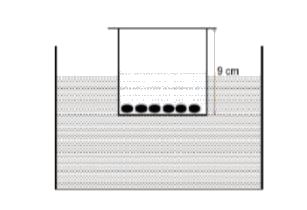A total solar eclipse is observed from the earth. At the same an observer on the moon views the earth. She is most likely to see (E denotes the earth)

a
b
c
d
The correct Answer is:B
Step by step video, text & image solution for A total solar eclipse is observed from the earth. At the same an observer on the moon views the earth. She is most likely to see (E denotes the earth) by Physics experts to help you in doubts & scoring excellent marks in Class 12 exams.
Topper's Solved these Questions
Similar Questions
A wide bottom cylindrical massless plastic container of height 9 cm has 40 identical coins inside it and is floating on water with 3 cm inside the water. If we start putting more of such coins on its lid. It is observed that after N coins are put, its equilibrium changes from stable to unstable. Equilibrium in floating is stable if the geometric center of the submerged portion is above the center of mass of the object) The value of N is closed to
 06:20View Solution
06:20View SolutionThe percentage change in the acceleration of the earth towards the Sun from a total eclipse of the Sun to the point where the Moon is on a side of earth directly opposite to the Sun is
03:53View SolutionA star is going away from the earth. An observer on the earth will see the wavelength of light coming from the star
View SolutionWhich of the following statements is/are correct?
1 Lunar eclipse takes place when the Earth comes directly between the Sun and the Moon
2.Solar eclipse happens when the Moon comes directly between the Sun and the Earth
3.Lunar eclipse takes place when the Sun comes directly between the Earth and the Moon
4.Solar eclipse happens when the Earth comes directly between the Sun and the Moon
Select the correct answer using the code given below: Code02:41View Solutionएक तारा पृथ्वी से दूर जा रहा है। पृथ्वी पर एक प्रेक्षक तारे से आते प्रकाश की तरंगदैर्घ्य देखेगा
07:46View SolutionDuring total solar eclipse, the spectrum of the sunlight observed is
07:46View SolutionDuring total solar eclipse, the spectrum of the sunlight observed is
02:14View Solutionपृथ्वी से चन्द्रमा की दूरी लगभग पृथ्वी की त्रिज्या की 60 गुनी है। चन्द्रमा से देखने पर पृथ्वी का व्यास (लगभग डिग्री में) क्या होगा?
08:14View SolutionThe percentage change in the acceleration of the earth towards the Sun from a total eclipse of the Sun to the point where the Moon is on a side of earth directly opposite to the Sun is
03:42View Solutionसूर्य, पृथ्वी तथा चन्द्रमा की स्थिति दर्शाते हुए नामांकित चित्र बनाइए :
(i) सूर्य ग्रहण के दौरान
(ii) चन्द्र ग्रहण के दौरान।02:07View Solution
What is the position of an observer on the Earth who sees a partial solar eclipse?01:11View SolutionA solar eclipse occurs when the earth, the sun and the moon are in the same plane and
07:07View SolutionThe percentage change in the acceleration of the earth towards the Sun from a total eclipse of the Sun to the point where the Moon is on a side of earth directly opposite to the Sun is
View SolutionThose who observe the moon from any point on the earth see only one face of it. Why?
02:04View SolutionA star is going away from the earth. An observer on the earth will see the wavelength of light coming from the star
02:19View Solution

